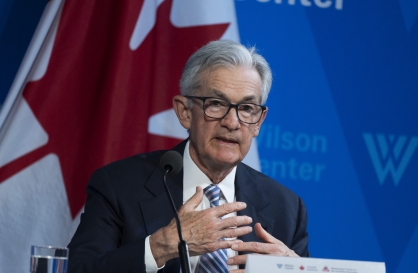For all the talk of America’s decline and China’s rise, Asians still seem obsessed with events in one corner of Washington, DC: the Federal Reserve.
This week’s meeting of the Federal Open Market Committee was the first I’d observed from Asia in 15 years. During that period, China’s economy has grown from about the size of Italy’s to surpass Germany and Japan and is now easily the world’s second-largest. Popular commentary and weighty tomes from academia, business, government and think-tank land are replete with data and anecdotes describing China’s growing economic clout in Asia and the US’s receding influence.
Yet this week, it was like I’d never been away. Television, print and online media offered saturation coverage of the Fed’s statement with the subtlest changes in sentence structure pored over at length. Talking heads opined and analyst notes proliferated. And that’s when the Fed didn’t do anything. Just imagine if its meeting had featured projections, a press conference and the famous dots.
By contrast, policy choices by the People’s Bank of China barely rated a mention. There may be a couple of explanations for this. While far from perfect, the Fed is radically transparent compared with the PBOC. We’ve known since last year that a meeting was scheduled this week.
The US is still the world’s largest economy, plus the size and influence of its capital markets -- and foreign participation in them -- dwarf any other. Asian economies in particular are more immediately and dramatically affected by changes in US monetary policy than most. Several important players maintain either real or de facto pegs to the dollar. The bulk of the region’s currency reserves are in dollars and quite a few central banks intervene periodically to manage their exchange rates versus the greenback. Globally, almost 90 percent of currency trading has the dollar on one side of the trade.
And it’s probably fair to say investors and economists are starting to sense some sort of inflection point approaching on inflation in the US. It’s been receding since hitting the Fed’s 2 percent target in February, even as the central bank is still committed to a gradual tightening of policy.
Some Fed officials are starting to question the model that links low unemployment to higher wages and inflation. So people are on the hunt for small changes in language that could convey something big; Fed statements and speeches are scrutinized in microscopic detail. While it’s become more open over the years, the PBOC doesn’t offer anywhere near the same degree of public material to examine.
That said, investors may be displaying a bit of a blind spot here. After all, when China’s markets gyrated in 2015, it was enough to give the Fed some pause in its campaign to slowly remove the accommodation of the crisis years.
Today, China’s bond market is the third largest in the world and is growing fast. Michael Spencer, chief Asia economist at Deutsche Bank AG, notes that many -- mistakenly -- still see China’s capital markets as closed and of little relevance to foreign markets. That’s at odds with China’s growing influence over capital flows and growth generally.
Many observers may also be misjudging the central bank’s policy stance. “Investors are not particularly focused on the PBOC because they assume it has a strong bias towards an easy policy stance and there’s little risk of policy tightening,” says Spencer. “But monetary conditions have been getting tighter in China and with core inflation rising steadily over the past year, and at a five-year high -- albeit only about 2.2 percent -- the outlook for domestic liquidity and therefore capital flows in and out of China is not so straightforward.”
Certainly, other Asian nations recognize the many ways, big and small, in which the US is losing ground to China. The country is throwing its weight around in the South China Sea again, not to mention the border with India. Many nations -- not just in Asia -- ignored US opposition to join the Asian Infrastructure and Investment Bank. And Chinese tourists are an increasingly valuable driver of consumption when they travel abroad. Few economists doubt China will ultimately become the world’s biggest economy, at least in terms of gross domestic product.
But, as China’s financial markets open further and grow more sophisticated, they will also inevitably have to command more attention in the region. In another 15 years, China’s dots are likely to be just as fascinating as the Fed’s.
--
By Daniel Moss
Daniel Moss has been the executive editor of Bloomberg News for global economics. -- Ed.
(Bloomberg)
This week’s meeting of the Federal Open Market Committee was the first I’d observed from Asia in 15 years. During that period, China’s economy has grown from about the size of Italy’s to surpass Germany and Japan and is now easily the world’s second-largest. Popular commentary and weighty tomes from academia, business, government and think-tank land are replete with data and anecdotes describing China’s growing economic clout in Asia and the US’s receding influence.
Yet this week, it was like I’d never been away. Television, print and online media offered saturation coverage of the Fed’s statement with the subtlest changes in sentence structure pored over at length. Talking heads opined and analyst notes proliferated. And that’s when the Fed didn’t do anything. Just imagine if its meeting had featured projections, a press conference and the famous dots.
By contrast, policy choices by the People’s Bank of China barely rated a mention. There may be a couple of explanations for this. While far from perfect, the Fed is radically transparent compared with the PBOC. We’ve known since last year that a meeting was scheduled this week.
The US is still the world’s largest economy, plus the size and influence of its capital markets -- and foreign participation in them -- dwarf any other. Asian economies in particular are more immediately and dramatically affected by changes in US monetary policy than most. Several important players maintain either real or de facto pegs to the dollar. The bulk of the region’s currency reserves are in dollars and quite a few central banks intervene periodically to manage their exchange rates versus the greenback. Globally, almost 90 percent of currency trading has the dollar on one side of the trade.
And it’s probably fair to say investors and economists are starting to sense some sort of inflection point approaching on inflation in the US. It’s been receding since hitting the Fed’s 2 percent target in February, even as the central bank is still committed to a gradual tightening of policy.
Some Fed officials are starting to question the model that links low unemployment to higher wages and inflation. So people are on the hunt for small changes in language that could convey something big; Fed statements and speeches are scrutinized in microscopic detail. While it’s become more open over the years, the PBOC doesn’t offer anywhere near the same degree of public material to examine.
That said, investors may be displaying a bit of a blind spot here. After all, when China’s markets gyrated in 2015, it was enough to give the Fed some pause in its campaign to slowly remove the accommodation of the crisis years.
Today, China’s bond market is the third largest in the world and is growing fast. Michael Spencer, chief Asia economist at Deutsche Bank AG, notes that many -- mistakenly -- still see China’s capital markets as closed and of little relevance to foreign markets. That’s at odds with China’s growing influence over capital flows and growth generally.
Many observers may also be misjudging the central bank’s policy stance. “Investors are not particularly focused on the PBOC because they assume it has a strong bias towards an easy policy stance and there’s little risk of policy tightening,” says Spencer. “But monetary conditions have been getting tighter in China and with core inflation rising steadily over the past year, and at a five-year high -- albeit only about 2.2 percent -- the outlook for domestic liquidity and therefore capital flows in and out of China is not so straightforward.”
Certainly, other Asian nations recognize the many ways, big and small, in which the US is losing ground to China. The country is throwing its weight around in the South China Sea again, not to mention the border with India. Many nations -- not just in Asia -- ignored US opposition to join the Asian Infrastructure and Investment Bank. And Chinese tourists are an increasingly valuable driver of consumption when they travel abroad. Few economists doubt China will ultimately become the world’s biggest economy, at least in terms of gross domestic product.
But, as China’s financial markets open further and grow more sophisticated, they will also inevitably have to command more attention in the region. In another 15 years, China’s dots are likely to be just as fascinating as the Fed’s.
--
By Daniel Moss
Daniel Moss has been the executive editor of Bloomberg News for global economics. -- Ed.
(Bloomberg)
-
Articles by Korea Herald









![[Today’s K-pop] BTS pop-up event to come to Seoul](http://res.heraldm.com/phpwas/restmb_idxmake.php?idx=644&simg=/content/image/2024/04/17/20240417050734_0.jpg&u=)
![[Graphic News] More Koreans say they plan long-distance trips this year](http://res.heraldm.com/phpwas/restmb_idxmake.php?idx=644&simg=/content/image/2024/04/17/20240417050828_0.gif&u=)







![[KH Explains] Hyundai's full hybrid edge to pay off amid slow transition to pure EVs](http://res.heraldm.com/phpwas/restmb_idxmake.php?idx=652&simg=/content/image/2024/04/18/20240418050645_0.jpg&u=20240419100350)

